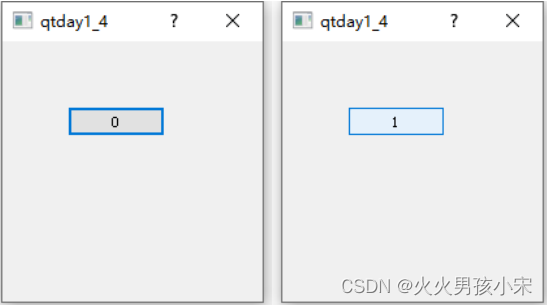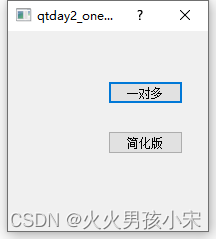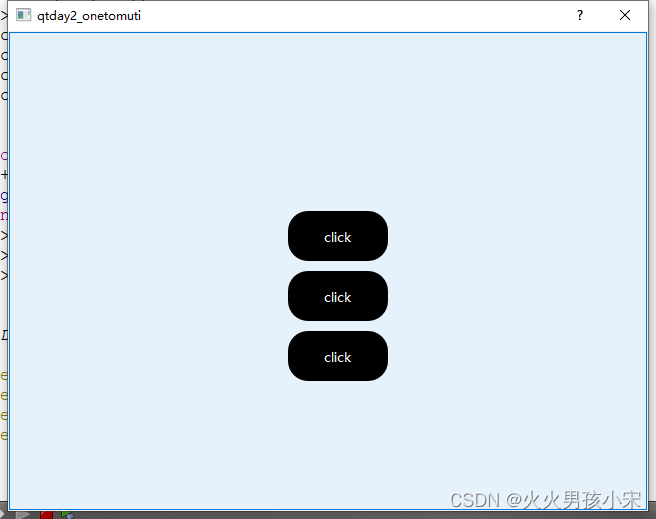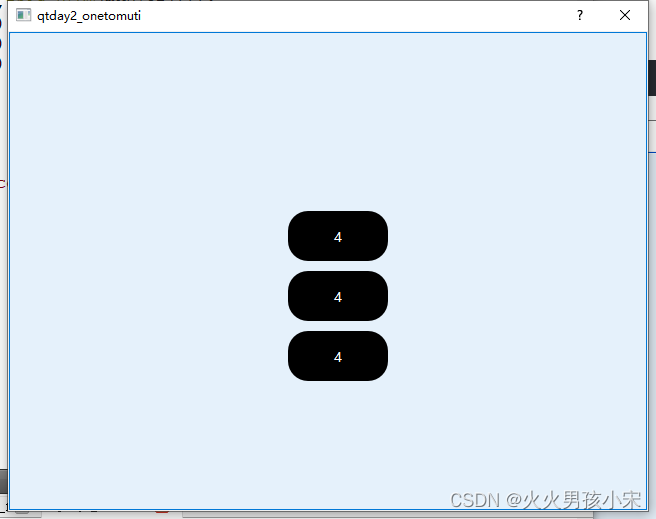信号槽的概念
信号函数与槽函数是 Qt 在 C++ 的基础上新增的特性,类似于其它语言中的回调机制
信号槽的使用更加简单,可以很容易地实现 不同组件对象之间的通信
可以理解为信号槽机制就是:“如果 A对象…,则 B对象… ”
使用信号槽的两个前提条件:
- 通信对象必须是从
QObject派生出来的 - 类的开始要有
Q_OBJECT宏
函数原型
信号槽的连接主要通过 QObject 类中的一个静态成员函数实现:

绝大多数自带默认值的参数都可以不看
此处第五个参数不考虑 ,指的是一种连接方式——自动连接
QObject::connect(const QObject * sender,
const char * signal,
const QObject * receiver,
const char * method) [static]
参数1:发射者对象——表示造成原因的对象
参数2:信号函数,当触发了原因时,发射者发射一个信号函数,需要 SIGNAL() 包裹
参数3:接收者对象——表示引起结果的对象
参数4:槽函数,接收者执行的具体功能函数,即结果触发函数调用,需要 SLOT() 包裹
实际上槽函数就是一种特殊的成员函数
信号槽连接的三种方式
为了方便逐步讲解,把信号槽连接由简至繁分为三种方式
自带信号 → 自带槽
自带信号 → 自定义槽
自定义信号 → 槽
方式一
自带信号 → 自带槽
这种方式不需要程序员手写任何函数的定义,只需要在 API 文档中找到对应的函数连接即可
【例子】 点击按钮关闭窗口
参数1:发射者,往往是一个名词——按钮对象
参数2:信号函数,往往是一个过去式动词——被点击函数
参数3:接受者,往往是一个名词——窗口对象
参数4:槽函数,往往是一个动词——关闭函数
代码如下:
dialog.h
#ifndef DIALOG_H
#define DIALOG_H
#include <QDialog>
// 按钮头文件
#include <QPushButton>
class Dialog : public QDialog
{
Q_OBJECT
public:
Dialog(QWidget *parent = 0);
~Dialog();
private:
// 头文件中声明
QPushButton *btn;
};
#endif // DIALOG_H
dialog.cpp
#include "dialog.h"
Dialog::Dialog(QWidget *parent)
: QDialog(parent)
{
// 构造函数中重设窗口大小
resize(300, 300);
// 构造函数中定义按钮
btn = new QPushButton("关闭", this);
// 设置按钮位置与宽高(x,y,w,h)
btn->setGeometry(50, 50, 100, 50);
// 信号槽连接
// QObject::connect(btn, SIGNAL(clicked()), this, SLOT(close()));
// 派生类中调用基类函数,存在继承关系可以将作用域限定符省略
//重写信号槽连接
connect(btn, SIGNAL(clicked()), this, SLOT(close()));
}
Dialog::~Dialog()
{
delete btn;
}
main.cpp
#include "dialog.h"
#include <QApplication>
int main(int argc, char *argv[])
{
QApplication a(argc, argv);
Dialog w;
// show()也是槽函数,所以槽函数是一种特殊的成员函数
w.show();
return a.exec();
}
方式二
自带信号 → 自定义槽
使用最多的一种方式
【例子】 点击按钮把窗口向右下角移动10√2个像素,同时输出调试信息
参数1:按钮对象
参数2:被点击函数
参数3:窗口对象
参数4:自定义槽函数 `mySlot`
代码如下:
dialog.h
#ifndef DIALOG_H
#define DIALOG_H
#include <QDialog>
#include <QPushButton>
#include <QDebug>
class Dialog : public QDialog
{
Q_OBJECT
public:
Dialog(QWidget *parent = 0);
~Dialog();
private:
QPushButton* btn;
// 1. 声明槽函数(最小权限法则)
private slots:
// 学名:驼峰命名法
// 第一个单词都小写,后面每个单词首字母大写
void mySlot();
};
#endif // DIALOG_H
dialog.cpp
#include "dialog.h"
Dialog::Dialog(QWidget *parent)
: QDialog(parent)
{
resize(200, 200);
btn = new QPushButton("自定义", this);
btn->move(50, 50);
// 3. 连接信号槽
connect(btn, SIGNAL(clicked()), this, SLOT(mySlot()));
}
// 2. 定义槽函数
void Dialog::mySlot()
{
// 先获得当前窗口的坐标
int x = this->x();
int y = this->y();
// 移动窗口
move(x+10, y+10);
// 输出移动之后的位置坐标
qDebug() << this->x() << "," << this->y();
}
Dialog::~Dialog()
{
delete btn;
}
main.cpp
#include "dialog.h"
#include <QApplication>
int main(int argc, char *argv[])
{
QApplication a(argc, argv);
Dialog w;
w.show();
return a.exec();
}
点击三次后的运行结果
Starting E:\QT\Tools\QtCreator\bin\build-qtday1_4-Desktop_Qt_5_2_1_MinGW_32bit-Debug\debug\qtday1_4.exe...
862 , 399
872 , 409
882 , 419
892 , 429
E:\QT\Tools\QtCreator\bin\build-qtday1_4-Desktop_Qt_5_2_1_MinGW_32bit-Debug\debug\qtday1_4.exe exited with code 0
方式三
自定义信号 → 槽
只有在少数情况需要用到自定义信号,下面例子强行使用自定义信号完成
【例子】 点击按钮关闭窗口

参数1:按钮对象
参数2:被点击函数
参数3:窗口对象
参数4:自定义槽函数 `mySlot`
代码如下:
dialog.h
#ifndef DIALOG_H
#define DIALOG_H
#include <QDialog>
#include <QPushButton>
#include <QDebug>
class Dialog : public QDialog
{
Q_OBJECT
public:
Dialog(QWidget *parent = 0);
~Dialog();
private:
QPushButton* btn;
// 1. 声明槽函数(最小权限法则)
private slots:
// 学名:驼峰命名法
// 第一个单词都小写,后面每个单词首字母大写
void mySlot();
// 3. 信号函数无权限
signals:
void mySignal();
};
#endif // DIALOG_H
dialog.cpp
#include "dialog.h"
Dialog::Dialog(QWidget *parent)
: QDialog(parent)
{
resize(200, 200);
btn = new QPushButton("杀鸡用牛刀", this);
btn->move(50, 50);
// 3. 连接信号槽
connect(btn, SIGNAL(clicked()), this, SLOT(mySlot()));
// 5. 连接自定义信号
connect(this, SIGNAL(mySignal()), this, SLOT(close()));
}
// 2. 定义槽函数
void Dialog::mySlot()
{
qDebug() << "发射自定义信号";
// 4. 发射自定义信号函数,信号函数无调用、无函数体
emit mySignal();
}
Dialog::~Dialog()
{
delete btn;
qDebug() << "窗口已关闭";
}
main.cpp
#include "dialog.h"
#include <QApplication>
int main(int argc, char *argv[])
{
QApplication a(argc, argv);
Dialog w;
w.show();
return a.exec();
}
运行结果
Starting E:\QT\Tools\QtCreator\bin\build-qtday1_4-Desktop_Qt_5_2_1_MinGW_32bit-Debug\debug\qtday1_4.exe...
发射自定义信号
窗口已关闭
E:\QT\Tools\QtCreator\bin\build-qtday1_4-Desktop_Qt_5_2_1_MinGW_32bit-Debug\debug\qtday1_4.exe exited with code 0
参数传递
编程预备知识
QPushButton的text :
QString属性表示显示的文字,对应的 getter 和 setter 为:
getter: QString text() const
setter: void setText(const QString & text)
setter 函数不是槽函数,因此需要自定义槽函数,在自定义槽函数中调用 text 属性的 setter函数 改变其数值
全局参数
在一个类中进行参数传递,可以通过成员变量或静态局部变量等方式
【例子】 点击按钮,按钮上显示当前按钮的点击次数
思路:

成员变量代码示例:推荐
dialog.h
#ifndef DIALOG_H
#define DIALOG_H
#include <QDialog>
#include <QPushButton>
class Dialog : public QDialog
{
Q_OBJECT
public:
Dialog(QWidget *parent = 0);
~Dialog();
private:
QPushButton* btn;
// 计数的成员变量
int count;// (1)可以在此处赋初值int count = 0;
// 1. 声明槽函数(最小权限法则)
private slots:
void mySlot();
};
#endif // DIALOG_H
dialog.cpp
#include "dialog.h"
Dialog::Dialog(QWidget *parent)
: QDialog(parent),count(0)// (2)构造初始化列表
{
// (3)构造函数中赋值count = 0;
resize(200, 200);
btn = new QPushButton("0", this);
btn->move(50, 50);
// 3. 连接信号槽
connect(btn, SIGNAL(clicked()), this, SLOT(mySlot()));
}
// 2. 定义槽函数
void Dialog::mySlot()
{
// 加
count++;
// int整数→QString字符串
QString text = QString::number(count);
btn->setText(text);
}
Dialog::~Dialog()
{
delete btn;
}
静态局部变量代码示例:不推荐
dialog.h
#ifndef DIALOG_H
#define DIALOG_H
#include <QDialog>
#include <QPushButton>
class Dialog : public QDialog
{
Q_OBJECT
public:
Dialog(QWidget *parent = 0);
~Dialog();
private:
QPushButton* btn;
// 1. 声明槽函数(最小权限法则)
private slots:
void mySlot();
};
#endif // DIALOG_H
dialog.cpp
#include "dialog.h"
Dialog::Dialog(QWidget *parent)
: QDialog(parent)
{
resize(200, 200);
btn = new QPushButton("0", this);
btn->move(50, 50);
// 3. 连接信号槽
connect(btn, SIGNAL(clicked()), this, SLOT(mySlot()));
}
// 2. 定义槽函数
void Dialog::mySlot()
{
static int count = 0;
// 加
count++;
// int整数→QString字符串
QString text = QString::number(count);
btn->setText(text);
}
Dialog::~Dialog()
{
delete btn;
}
静态局部变量没有成员变量好用
如果有多个Dialog对象窗口,多个窗口使用一个静态局部变量,点一个所有的都会随之改变
除非要做出此类效果,否则推荐使用成员变量
另外静态成员变量的生命周期较长,使用成员变量更加轻量化
运行结果

信号槽传参
信号槽传参主要在后期用于直接使用变量传递参数不方便的情况,此处仅用于讲解演示,并不是最优解法
【例子】 点击按钮,按钮上显示当前按钮的点击次数
思路:与全局变量所用思路不同,建议回头比对差异

代码如下:
dialog.h
#ifndef DIALOG_H
#define DIALOG_H
#include <QDialog>
#include <QPushButton>
class Dialog : public QDialog
{
Q_OBJECT
public:
Dialog(QWidget *parent = 0);
~Dialog();
private:
QPushButton* btn;
private slots:
// 自定义槽函数1
void mySlot();
// 与void valueSignal(int)连接的槽函数2
void valueSlot(int);
signals:
// 能携带参数的信号函数
// 信号函数不需要定义、不需要调用,直接发射
void valueSignal(int);
};
#endif // DIALOG_H
dialog.cpp
#include "dialog.h"
Dialog::Dialog(QWidget *parent)
: QDialog(parent)
{
resize(300, 300);
btn = new QPushButton("0", this);
btn->move(100, 100);
connect(btn, SIGNAL(clicked()), this, SLOT(mySlot()));
connect(this, SIGNAL(valueSignal(int)), this, SLOT(valueSlot(int)));
}
void Dialog::mySlot()
{
// 使用静态局部变量进行计数
static int count = 0;
// 发送自定义信号
emit valueSignal(++count);
}
// 此处不能使用哑元,要写上参数名,否则拿不到参数值
void Dialog::valueSlot(int count)
{
// 拿到传递过来的参数并设置显示
QString text = QString::number(count);
btn->setText(text);
}
Dialog::~Dialog()
{
delete btn;
}
运行结果 同上

相对于全局参数效率较低,能使用参数传递就不要使用信号槽传递参数
信号槽传递参数是为了在参数传递不方便的时候使用的一种方法
信号槽传递参数是为比较复杂的远距离通信设定的
远距离 不是现实的距离,而是编程中两个对象没有直接的关系
如果在一个类中的两个对象,他们之间触手可得,这就称不上 远距离 了
注意:
- 理论上可以传递任意个数的参数,但是实际上 1-2 个居多。
- 信号函数的参数个数必须大于等于槽函数的参数个数。
- 参数类型必须一一匹配
信号槽的对应关系
信号槽之间具有 一对多 和 多对一 的关系
一对多 指的是一个信号可以连接多个槽函数
多对一 指的是多个信号可以连接同一槽函数
一对多的情况可以优化为一对一
【例子】 一对多并优化成 简化版一对一
代码示例:
dialog.h
#ifndef DIALOG_H
#define DIALOG_H
#include <QDialog>
#include <QPushButton>
#include <QDebug>
class Dialog : public QDialog
{
Q_OBJECT
public:
Dialog(QWidget *parent = 0);
~Dialog();
private:
QPushButton* btn1;
QPushButton* btn2;
private slots:
// 两个槽函数
void mySlot1();
void mySlot2();
// 与btn2连接的槽函数
void mySlot();
};
#endif // DIALOG_H
dialog.cpp
#include "dialog.h"
Dialog::Dialog(QWidget *parent)
: QDialog(parent)
{
resize(200, 200);
btn1 = new QPushButton("一对多", this);
btn2 = new QPushButton("简化版", this);
btn1->move(100, 50);
btn2->move(100, 100);
// 一对多
connect(btn1, SIGNAL(clicked()), this, SLOT(mySlot1()));
connect(btn1, SIGNAL(clicked()), this, SLOT(mySlot2()));
// 所有的一对多都可以简化为一对一的信号槽
connect(btn2, SIGNAL(clicked()), this, SLOT(mySlot()));
}
void Dialog::mySlot1()
{
qDebug() << "1";
}
void Dialog::mySlot2()
{
qDebug() << "2";
}
void Dialog::mySlot()
{
// 槽函数是一种特殊的成员函数
// 可以直接调用
mySlot1();
mySlot2();
}
Dialog::~Dialog()
{
delete btn1;
delete btn2;
}
运行结果

Starting E:\QT\Tools\QtCreator\bin\build-qtday2_onetomuti-Desktop_Qt_5_2_1_MinGW_32bit-Debug\debug\qtday2_onetomuti.exe...
1
2
1
2
E:\QT\Tools\QtCreator\bin\build-qtday2_onetomuti-Desktop_Qt_5_2_1_MinGW_32bit-Debug\debug\qtday2_onetomuti.exe exited with code 0
Button一对多与Button简化版都可以实现信号槽
【例子】 多对一
代码示例:
dialog.h
#ifndef DIALOG_H
#define DIALOG_H
#include <QDialog>
#include <QDebug>
#include <QWidget>
#include <QPushButton>
#define QPushButton_STYTLE (QString("\
/*按钮普通态*/\
QPushButton\
{\
font-family:Microsoft Yahei;\
/*字体大小为20点*/\
font-size:10pt;\
/*字体颜色为白色*/\
color:white;\
/*背景颜色*/\
background-color:rgb(0 , 0 , 0);\
/*边框圆角半径为8像素*/\
border-radius:20px;\
}\
/*按钮悬停态*/\
QPushButton:hover\
{\
/*背景颜色*/\
background-color:rgb(0 , 0 , 0);\
}\
/*按钮按下态*/\
QPushButton:pressed\
{\
color:black;\
/*背景颜色*/\
background-color:rgb(255 , 255 , 255);\
/*左内边距为3像素,让按下时字向右移动3像素*/\
padding-left:3px;\
/*上内边距为3像素,让按下时字向下移动3像素*/\
padding-top:3px;\
}"))
class Dialog : public QDialog
{
Q_OBJECT
public:
Dialog(QWidget *parent = 0);
~Dialog();
private:
QPushButton *btn;
QPushButton *btn1;
QPushButton *btn2;
QPushButton *btn3;
int count;
private slots:
void mySlot();
};
#endif // DIALOG_H
dialog.h
#include "dialog.h"
Dialog::Dialog(QWidget *parent)
: QDialog(parent),count(0)
{
resize(640,480);
btn=new QPushButton(NULL,this);
btn->resize(640,480);
btn1=new QPushButton("click",this);
btn1->setStyleSheet(QPushButton_STYTLE);
btn1->move(280,240);
btn1->resize(100,50);
btn2=new QPushButton("click",this);
btn2->setStyleSheet(QPushButton_STYTLE);
btn2->move(280,180);
btn2->resize(100,50);
btn3=new QPushButton("click",this);
btn3->setStyleSheet(QPushButton_STYTLE);
btn3->move(280,300);
btn3->resize(100,50);
connect(btn,SIGNAL(clicked()),this,SLOT(mySlot()));
connect(btn1,SIGNAL(clicked()),this,SLOT(mySlot()));
connect(btn2,SIGNAL(clicked()),this,SLOT(mySlot()));
connect(btn3,SIGNAL(clicked()),this,SLOT(mySlot()));
}
void Dialog::mySlot(){
count++;
qDebug()<<count;
QString test=QString::number(count);
btn1->setText(test);
btn2->setText(test);
btn3->setText(test);
}
Dialog::~Dialog()
{
delete btn;
delete btn1;
delete btn2;
delete btn3;
}
运行结果
Starting E:\QT\Tools\QtCreator\bin\build-qtday2_onetomuti-Desktop_Qt_5_2_1_MinGW_32bit-Debug\debug\qtday2_onetomuti.exe...
1
2
3
4
E:\QT\Tools\QtCreator\bin\build-qtday2_onetomuti-Desktop_Qt_5_2_1_MinGW_32bit-Debug\debug\qtday2_onetomuti.exe exited with code 0


总结
后会有期





















 1366
1366











 被折叠的 条评论
为什么被折叠?
被折叠的 条评论
为什么被折叠?








